Banana plants belong to the family Musaceae and are the largest perennial herbaceous plants in the world. Banana fruit is grown for its fleshy, curved shape. There is a thick, tropical pseudostem (not a stem, but rolled leaf bases) with spirally arranged leaves at the top, which is tall, tropical, and tree-like. The leaves are large and blade-like with a pronounced midrib and apparent veins. A hanging cluster of fruits develops from each pseudostem’s group of flowers, which may also be called ‘Banana hearts.
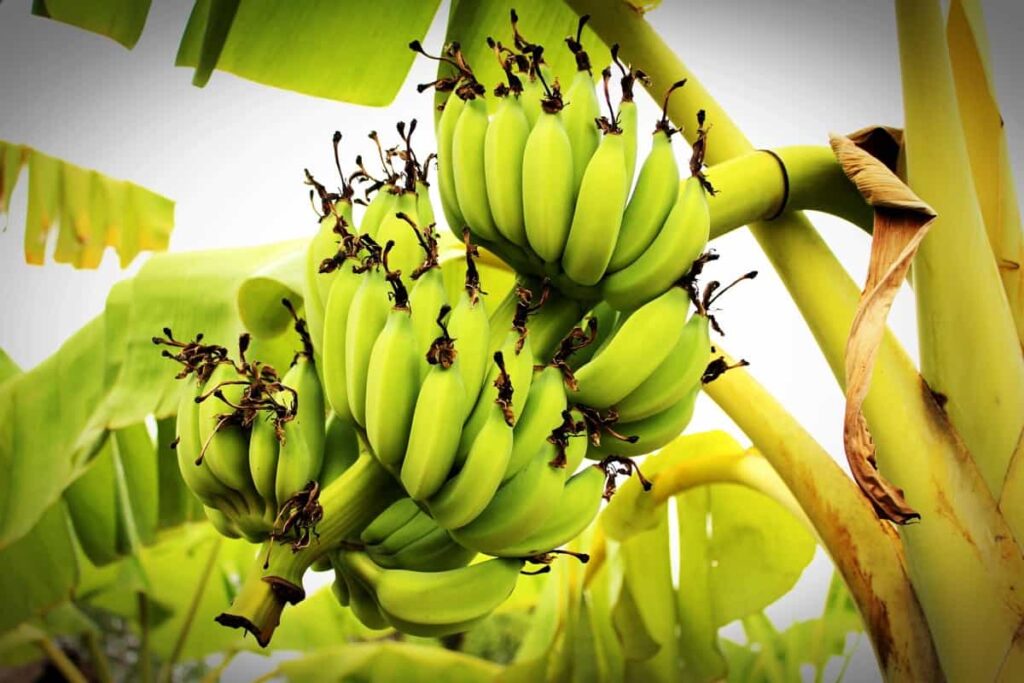
Bananas are host to a wide range of pests and diseases. Many fungal, viral, and bacterial diseases, insect pests, and nematodes infest the Banana crop and reduce production, productivity, and quality. Here are some pests and diseases that affect the crop quality and yield in Banana farming.
How to control pests and diseases in Bananas
Rhizome weevil
Grubs feed on the corm and rootstock, creating irregular tunnels. The tunnels are roughly circular and can reach a diameter of about 8 mm. Plants that are neglected are most likely to suffer damage. Fertile soils and good crop farming rarely cause serious problems. It is common for Banana weevil populations to be low in fields that have just been planted. The temperature will significantly affect Banana weevil damage in low-altitude areas more than in highland areas.
Symptoms
- Young grubs first tunnel along the surface of the leaf until they can penetrate the inner leaf sheaths
- As the infection progresses, it spreads to the pseudostem’s lower part and the area around the base of the leaf sheath.
- Then they bore into the pseudostem base, rhizome/corm, the base of suckers, and roots.
- The infested plant shows yellowing and withering of leaves, slowed plant growth, root destruction, reduced fruit production
- Young suckers wither and do not develop when infested.
- Mild to strong winds can easily blow plants over.
Biological control and management
- Release predatory ants such as the bigheaded ant, and Tetramorium spp. are important predators of the Banana weevil.
- Planting of healthy suckers. Planting infected rhizomes increase the damage.
- It is essential to obtain planting material from plantations without weevils and inspect it carefully by taking a slice or two from each plant.
- In addition to weeding, manuring, and mulching, good husbandry practices produce vigorous Banana plants that are more resilient to weevils.
In case you missed it: How to Start Banana Farming in the USA: A Step-By-Step Guide to Planting to Harvesting
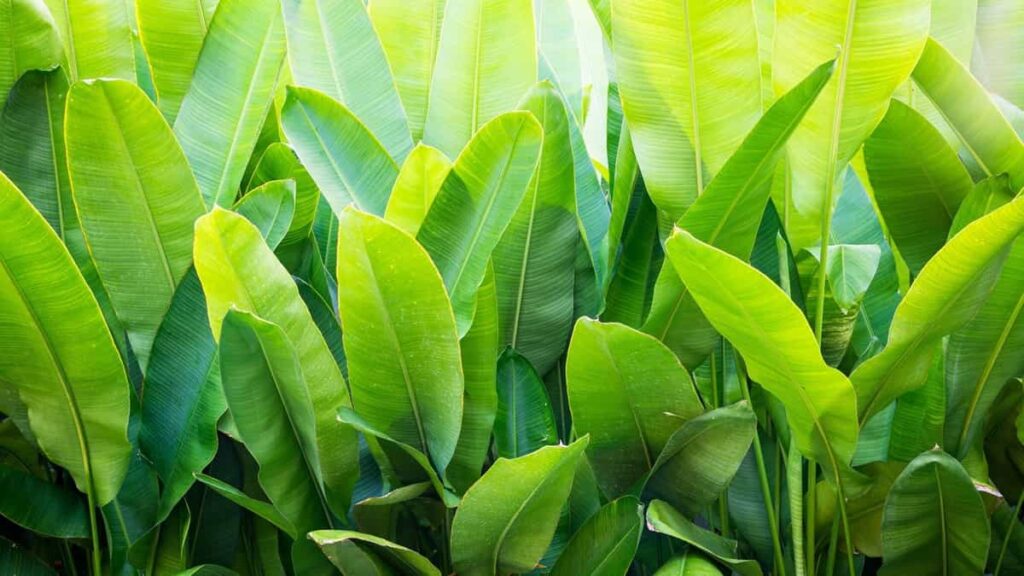
Chemical control
- Soil application of carbufuran at 2gm per plant.
- Apply Furadan 3G at 20 gms, Phorate 10G at 12 gms, or Neem cake at 1/2 Kg per pit during planting.
- Suckers should be dipped in 0.1 percent quinalphos emulsion before planting.
- Suckers should be dipped in Monocrotophos solution (1-liter water) for about 20 minutes to kill eggs and grubs.
- Apply castor cake of 250 grams or Carbary dust of l 50 grams dust or phorate 10g per pit before planting also prevents infestation
Pseudostem weevil
The adult weevils are black-colored, about 30 mm long, with a pointed head and shiny armor. They are predominantly nocturnal but may also be found in the daytime during cooler months or cloudy days. Volatile substances released by Banana plants attract them. Females cut slits in leaf sheaths and lay white creamy, elliptical eggs superficially inside.
Symptoms
- Infestation of the weevil typically starts in 5-month-old plants.
- Pinhead-sized holes on the stem are the first signs of infestation
- Extrusions of fibrous material from leaf petioles
- The pseudostem is covered with adult weevils, and a gummy substance is exuded from the holes
- When the stem is split open, the leaf sheath and pseudostem exhibit extensive tunneling during the advanced stages of infestation
- A foul odor is emitted when rot occurs due to secondary infection by pathogens.
- The fruits do not develop properly when the stem and peduncle are tunneled after flowering, resulting in a dehydrated bunch that ripens prematurely.
Biological control
- Weevils die on their own after infection with 20 grams of Beauveria bassiana fungus or Heterorhabditis indica nematode on the cut surface of the longitudinal split traps.
- Banana weevils are hunted by predatory ants such as big-headed ants and Tetramonrium species.
- When planting suckers, dip them in a 20% neem seed solution
- In the field, Steinerma and Heterohabditis species attack both adults and grubs.
Chemical control
- Monocrotophos solution (150 ml in 35 ml water) is injected into the stem at 2 and 4 feet above ground level at a 30-degree angle on either side of the plant. After flowering, injections should not be given. Injection needles should reach no more than two or three leaf sheaths without touching the center core.
- Application of Furadan 3G at 20 grams or Phorate 10 G at 12 grams, or neem cake at 1/2 Kg per pit during planting
- Chlorpyriphos (2.5 ml per liter) + 1 ml sticking agent should be applied to the cut end of the leaf petiole
- After harvesting a Banana bunch, cut the tree at the base and treat it with 100ml Carbaryl (2 grams per liter) or apply 10g Beauveria bassiana
In case you missed it: A Step-By-Step Guide to High Density Fruit Farming: For Guava, Banana, Mango, Pineapple, Lemon, Papaya, Litchi, and Apple
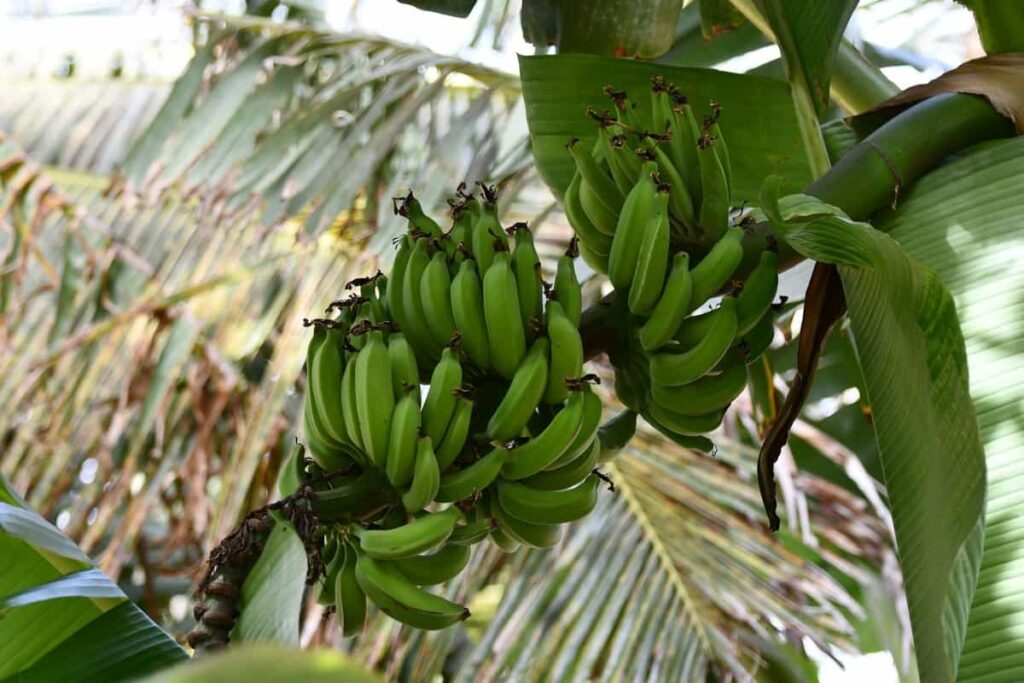
Fruit rust thrips
The pest is most commonly transmitted via infested plant material or, to a lesser degree, by insects flying between trees. Adults are slim, yellow to brown, about 1.3 mm in size, and have narrow fringed wings with two dark areas on the forewings. The female lays tiny eggs (not visible to the naked eye) on the underleaf sheaths and where fruits touch the plant. After about seven days, the wingless, white-to-cream larvae hatch. Then they move to the ground, enter the soil on the plant base, and pupate.
Symptoms
- The colonies congregate in water-soaked smoky areas where they feed and oviposit between touching or adjacent fruit. As a result, these areas develop the typical rusty-red to dark brown-black discoloration.
- Yellowing of leaves and further rusty growth of the fruit
- The fruit’s taste and texture within these peels are not affected, but the exterior discoloration reduces its marketability.
- Cracks may form in the fruit’s skin, and the fruit may split in severe cases
Biological method
Lacewings and ladybird beetles are coccinellid predators that can help control rust thrips on plants, and ants can help remove pupae from the soil.
Chemical method
- Spray or inject Monocrotophos at 0.05% on the inflorescence before the unfurling of top most bract.
- Bunches, pseudostem, and suckers should be sprayed with chlorpyriphos
- Soil application with Fipronil and Bifenthrin
Aphids
Aphid is a severe problem to Bananas, not for feeding habits, but it acts as a vector of Banana bunchy top disease, the most damaging virus disease of this crop. Black-colored aphid colonies are found in the crown of the plants. Young suckers are usually the most heavily infested and show bunchy top symptoms.
Symptoms
- In the outer base of the pseudostem, the nymphs and adults congregate
- The dispersing agent of nymphs is always ants, which accompany aphids
- Plants produce honeydew secretions, which attract ants
- Aphids consume sap from plants and reduce their growth and vigor
- In addition, they act as vectors for the Banana Bunchy Top Virus (BBTV).
Biological control
- Introduction braconid wasps, Lysiphlebius testaceipes, as parasitoids to parasitize the aphids
- Release predators such as ladybird beetles and lacewings in the field, which are very active aphid feeders
- Apply bio-control agents, like the entomopathogenic fungus, Beauveria bassiana, in the Banana fields
In case you missed it: Top Varieties of Bananas in India: Best List, Banan Types for Higher Profits, and Yield
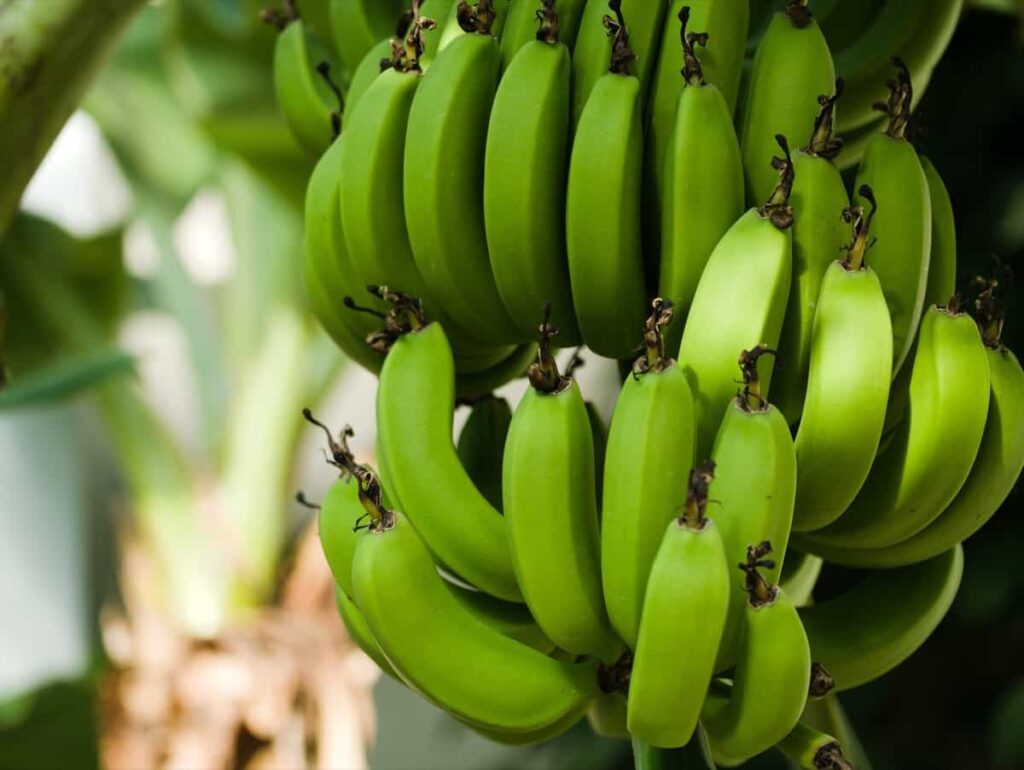
Chemical control
- On petioles, furled leaves, whorls, or young suckers of plants, spray soapy water or insecticidal soap thoroughly
- Infested plants and suckers should be sprayed with Dimethoate (75 ml per 100 liters), Diazinon (1.5 ml per liter), or Acephate (1.3 grams per liter)
- The spray should be composed of either Methyl Demeton 25 EC 0.05% or Monocrotophos 36 SL 0.072 %
- Plants should be injected with 1 ml of Monocrotophos 36 SL diluted with 4 ml of water per plant. After flowering, Monocrotophos should not be injected
Nematodes
It is challenging to see Banana lesion nematodes because they are so small. They feed the Banana roots. Their presence causes purple-black dead areas on the surface and inside roots, but the inner central parts of roots remain whitish. Root growth is disrupted by feeding damage, resulting in weaker plants and lower yields. Despite feeding inside Banana roots, nematodes can move through the soil to new roots. Control measures cannot reach these hidden nematodes.
Symptoms
- When you split open the roots, you can see reddish-brown to black lesions that are elongated and reddish. There is an eventual blackening and death of roots.
- The root system is destroyed or weakened by nematode attacks and secondary rot organisms.
- The fruiting of infested plants is poor, and they lack vigor.
- Wind easily blows over such plants, exposing their roots.
Biological control
- Use disease-free suckers from clean nurseries or clean land for planting.
- Kill nematodes in roots of young Banana transplants (suckers) with hot water before transplanting: pare suckers from roots and old external plant layers. Then, suckers are placed for 1/2 minute into a bath of boiling water or 10 minutes into a bath of hot non-boiling water.
- Apply large quantities of mulch around stems to stimulate root growth and reduce the effects of nematodes’ damage.
Chemical control
Application of Furadan 3G at 20 grams, Phorate 10G at 12 grams, neem cake at 1/2 Kg per pit at planting
Diseases in Banana cultivation
Panama Wilt
The cause of this disease is Fusarium oxysporum, subspecies cubense. It is a soil-borne fungal disease that enters plants through their roots. In poorly drained soil, it is most serious. Symptoms include yellowing of lower leaves, including blades and petioles. With continuous Banana cropping on poor soil, Banana wilt is severe. Warm soil temperatures, poor drainage, light soils, and high soil moisture facilitate the spread of this disease.
Symptoms
- Yellowing of the lowermost leaves, starting from the margin to the midrib of the leaves
- The yellowing extends upwards, and finally, the heart leaf alone remains green for some time and is also affected.
- There is a break in the leaves near the base, and the leaves hang down around the pseudostem.
- Longitudinal splitting of pseudostem. Discoloration of vascular vessels as red or brown streaks.
Chemical control and management methods
- Cultivation of resistant cultivars toward younger leaves
- Trim and treat the suckers in 0.1% Bavistine before planting.
- Keep good drainage, apply a lot of organic manure in the field, and use healthy planting material.
- Dip suckers in carbendazim (10 grams per 10 liters of water) are also recommended, followed by bimonthly drenching after planting.
- Applying bioagents, such as Trichoderma viride or Pseudomonas fluorescence in the soil, is effective.
In case you missed it: Top 20 Steps to Boost Your Banana Fruit Yield: How to Increase Fruit Size, and Production
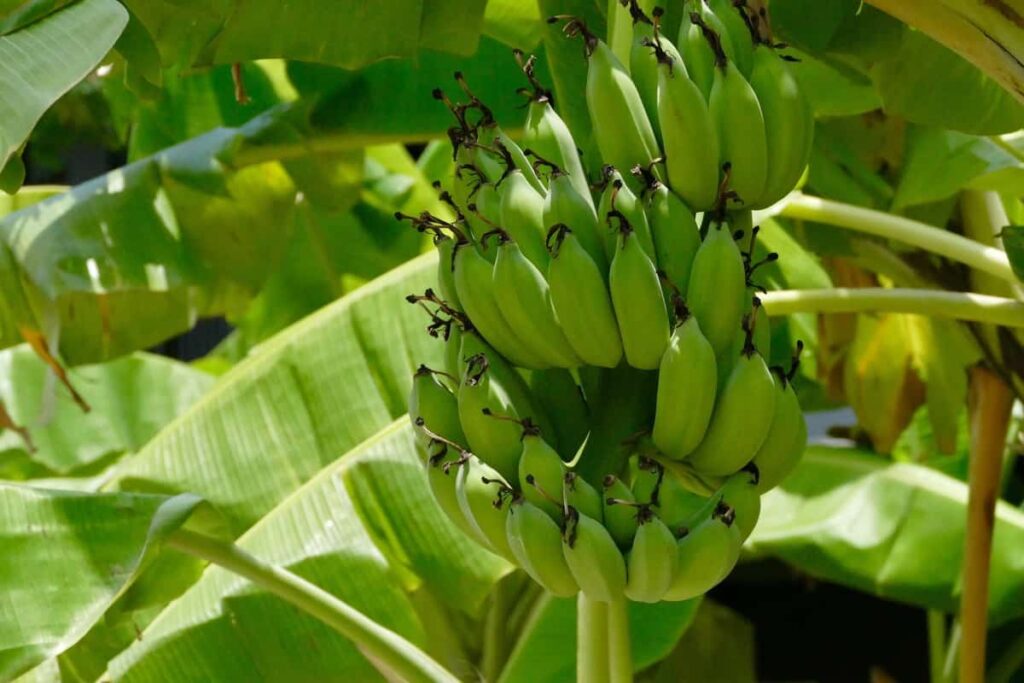
Mycosphaerella leaf spot, yellow Sigatoka, black Sigatoka
Sigatoka disease is caused by Mycosphaerella musicola and is one of the serious diseases affecting the Banana crop. Initial symptoms appear in the form of light yellowish spots on the leaves. A few of these enlarge and become oval; the color also changes to dark brown. Still later, the center of the spot dies, turning light grey and surrounded by a brown ring.
In severe cases, numerous spots coalesce, killing large parts of the leaf. Rainfall, dew, and temperature determine the spread of the disease. Conditions favoring mass infection are most common during the rainy season with a temperature above 21°C.
Symptoms
- Early symptoms appear on leaves three or four from the top, i.e., on young leaves.
- Small spindle-shaped spots on foliage with a greyish center and yellowish halo running parallel to veins.
- Suppose the fruit is nearing maturity at the time of heavy infection. In that case, the flesh ripens but evenly, individual Bananas appear undersized, and their flesh develops a buff pinkish color and stores poorly.
Chemical control and management methods
- Remove infected leaves and destroy
- Keep proper drainage and avoid water logging.
- Spray Mancozeb 75% WP at 1250 grams per hectare or Carbendazim 50% WP at 500 grams per hectare.
- Foliar spray of Copper Oxychloride (3 grams per liter of water) or Thiophanate Methyl 1 gram per liter of water) control the disease effectively.
Anthracnose
Gloeosporium musae causes this disease. Air-borne conidia spread the disease, and numerous insects that frequently visit Banana flowers also spread the disease. The disease is favored by high atmospheric temperature and humidity, wounds and bruises caused in the fruit, and susceptibility to the variety.
Symptoms
- Small and circular black spots develop on the affected fruits initially. Then these spots enlarge in size and turn to brown color
- The fruit’s skin turns black and shrivels and becomes covered with characteristic pink acervuli. Then, finally, the whole finger is affected. Later the disease spreads and affects the entire bunch.
- As a result of the disease, the fruits are prematurely ripened and shriveled, and covered with pink spore masses.
- Sometimes the central stalk of the bunch may become diseased. Infected fruits become black and rotten
Chemical control and management methods
- Spraying of Chlorothanlonil (0.2%) and Carbendazim 50% WP (1 %) four times at 15 days intervals is recommended.
- Minimizing bruising, proper sanitation of handling, and rapid cooling to 14°C are essential in reducing the disease in cold storage.
Bunchy top/curly top disease
Banana bunchy top virus causes this disease. The symptoms are caused by a virus transmitted from tree to tree or between fields by the Banana aphid. Transmission over larger distances can occur via carrying infected planting material from one plantation to another. Plants do not recover from an infection. Primary infections through infected seedlings are generally worse than secondary infections via aphids. The symptoms are also exacerbated during the spring or warm, dry weather.
Symptoms
- Initial symptoms include the appearance of dark-green streaks on petioles, midribs, and veins on the underside of new leaves.
- Later, leaf laminae can also show these tiny dark green dots and dashes along the veins (called Morse code pattern).
- Affected leaves are stunted, slim, erect, and have curly and chlorotic margins that tend to turn necrotic.
- In advanced infections, new leaves show a worsening of these symptoms.
- The crown is characterized by the accumulation of small pale green or yellow leaves that form a “bunchy top.
- Overall growth is stunted, and the plant may not produce bunches or fruits. If produced at all, fruits are deformed and undersized.
In case you missed it: G9 Tissue Culture Banana Cultivation, Farming Practices
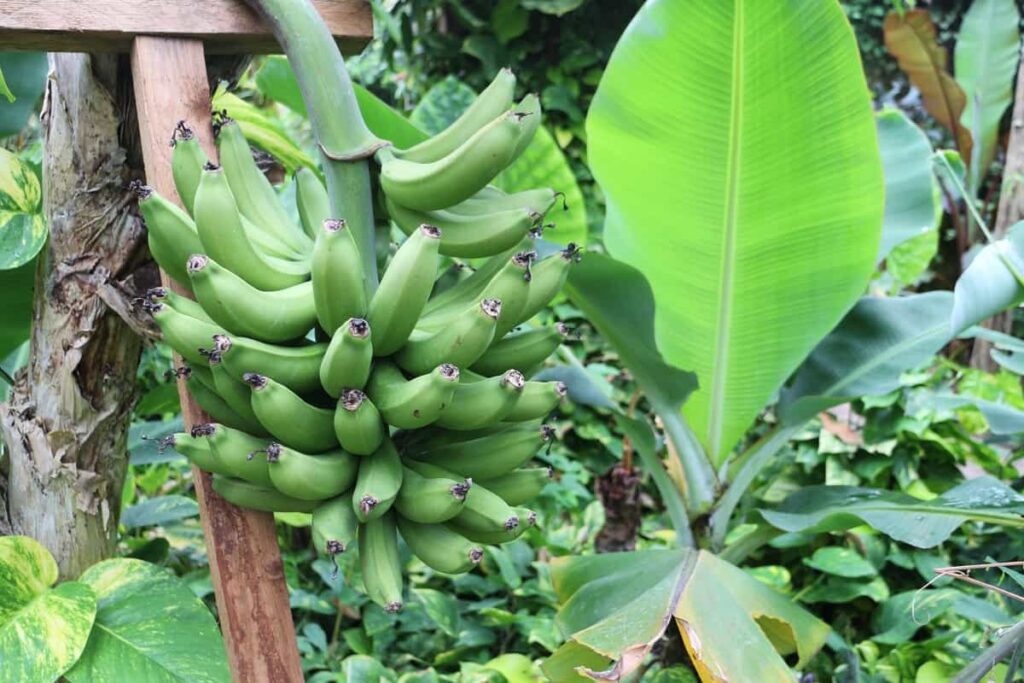
Chemical control and management methods
- Use virus-free planting materials
- For early detection of infested suckers, keep your field clean and weed-free
- Fernoxone solution (50 grams in 400 ml of water) should be injected into the plants in 4 ml doses.
- Plants are injected with monocrotophos 4 ml (1:4) at 45-day intervals from the third month onwards
- Spray plants with phosphamidon 1 ml per liter, Methyldemeton 2 ml per liter, or Monocrotophos 1 ml per liter.
Banana bract mosaic virus (BBMV)
The symptoms are caused by a virus that affects Banana trees at different growth stages. Several species of aphids transmit the disease in a non-persistent manner. The virus, acquired while feeding on infected plants, only survives for a short period in the vector. Its common name comes from the characteristic mosaic symptoms on the flower bracts. However, the virus can spread quickly, and severe infection can lead to fruit yield and quality losses.
Symptoms
- The most obvious symptom appears on the bracts of the inflorescence as a reddish-brown mosaic pattern.
- Bracts are the name for the small leaves that cover the rows of flowers on the flower stalk.
- In young plants, chlorotic or red-brown spindle-shaped lesions and streaks can be found on leaf petioles or midribs.
- Occasionally, they also appear on the blade parallel to the veins or on the stem of fruit bunches.
- When the dead leaves are pulled off, dark brown blemishes or streaks are visible on the internal tissue.
- Growth defects on bunches and deformed fruits are also characteristic of the disease.
Chemical control and management methods
- Diseased plants should be removed as soon as they are noticed to prevent the spread of the disease
- New plantings should be made with disease-free planting materials
- The virus can survive in weeds in the off-season, so weeds in nearby areas should be removed
- Detection of diseased plants in the field early by inspecting plantings regularly and eradicating them as soon as possible
- Control insect vector by spraying Phosphomidon at 1 ml per liter, Methyl Demeton at 2 ml per liter, or Monocrotophos at 1ml per liter.
Conclusion
Disease diagnostic testing methods have made disease management more accessible in recent years. Increased quarantine and protection measures, fungicides, breeding-resistant varieties, and ongoing monitoring can minimize diseases. A good farm management approach is essential for managing Banana pests with Integrated Pest Management.
- Economical Aquaculture: A Guide to Low-Budget Fish Farming
- 15 Common Planting Errors That Can Doom Your Fruit Trees
- How to Make Houseplants Bushy: Effective Tips and Ideas
- Innovative Strategies for Boosting Coconut Pollination and Yield
- Pollination Strategies for Maximum Pumpkin Yield
- The Complete Guide to Chicken Fattening: Strategies for Maximum Growth
- Natural Solutions for Tulip Problems: 100% Effective Remedies for Leaf and Bulb-Related Issues
- Revolutionizing Citrus Preservation: Towards a Healthier, Greener Future
- Natural Solutions for Peony Leaf and Flower Problems: 100% Effective Remedies
- Maximizing Profits with Avocado Contract Farming in India: A Comprehensive Guide
- Natural Solutions for Hydrangea Problems: 100% Effective Remedies for Leaf and Flowers
- The Ultimate Guide to Choosing the Perfect Foliage Friend: Bringing Life Indoors
- From Sunlight to Sustainability: 15 Ways to Use Solar Technology in Agriculture
- The Ultimate Guide to Dong Tao Chicken: Exploring from History to Raising
- The Eco-Friendly Makeover: How to Convert Your Unused Swimming Pool into a Fish Pond
- Mastering the Art of Delaware Chicken Farming: Essentials for Healthy Backyard Flocks
- 20 Best Homemade Fertilizers for Money Plant: DIY Recipes and Application Methods
- How to Craft a Comprehensive Free-Range Chicken Farming Business Plan
- Brighten Your Flock: Raising Easter Egger Chickens for Beauty and Bounty
- How to Optimize Your Poultry Egg Farm Business Plan with These Strategies
- Subsidy for Spirulina Cultivation: How Indian Government Schemes Encouraging Spirulina Farmers
- Ultimate Guide to Raising Dominique Chickens: Breeding, Feeding, Egg-Production, and Care
- Mastering the Art of Raising Jersey Giant Chickens: Care, Feeding, and More
- Ultimate Guide to Raising Legbar Chickens: Breeding, Farming Practices, Diet, Egg-Production
- How to Raise Welsummer Chickens: A Comprehensive Guide for Beginners
- How to Protect Indoor Plants in Winter: A Comprehensive Guide
- Ultimate Guide to Grow Bag Gardening: Tips, Tricks, and Planting Ideas for Urban Gardeners
- Guide to Lotus Cultivation: How to Propagate, Plant, Grow, Care, Cost, and Profit
- Agriculture Drone Subsidy Scheme: Government Kisan Subsidy, License, and How to Apply Online
- Ultimate Guide to Raising Araucana Chickens: Breed Profile, Farming Economics, Diet, and Care
- Bringing Hydroponics to Classroom: Importance, Benefits of Learning for School Students
- Ultimate Guide to Raising Polish Chickens: Breed Profile, Farming Economics, Diet, and Care
- Ultimate Guide to Raising Australorp Chickens: Profile, Farming Economics, Egg Production, Diet, and Care
- Silkie Chicken Farming: Raising Practices, Varieties, Egg Production, Diet, and Care
- Sussex Chicken Farming: Raising Practices, Varieties, Egg Production, Diet and Care
- Homemade Feed Formulations for Livestock: Discover Cost-effective Starter to Finisher Feed Recipes